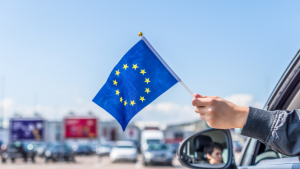Beginning in late 2025, travelers entering Europe will experience a new way of crossing borders. The European Union’s Entry/Exit System (EES) will replace the long-standing passport stamping process with a fully digital, biometric record designed to improve security and streamline travel.
For organizations and frequent travelers who rely on G3 Global Services for visa and passport support, understanding how the EES works—and how it affects future trips—is key to ensuring seamless travel throughout Europe.

What Is the EU Entry/Exit System (EES)?
The Entry/Exit System (EES) is a new automated border management program developed by the European Union. It will electronically record the time, date, and place of entry and exit for all non-EU and non-Schengen nationals visiting the Schengen Area for short stays (up to 90 days within a 180-day period).
Instead of manual passport stamps, the system will capture:
- Biometric data (facial image and fingerprints)
- Passport details
- Time and place of entry and exit
The primary goals of EES are to:
- Strengthen border control and identity verification
- Detect overstays and illegal entries more efficiently
- Reduce wait times for repeat travelers once registered
Over time, traditional passport stamping at Schengen borders will be phased out entirely.
When Does the EES Launch?
The European Union has announced that the EES will launch on October 12, 2025, with full implementation expected by April 10, 2026.
During the transition period, some border posts may continue manual stamping alongside the new system. G3 Global Services recommends that both individual and corporate travelers allow additional time at entry points during the first months of rollout.
Who Does the EES Affect?
The EES applies to all non-EU and non-Schengen visitors entering the Schengen Area for short-term stays (up to 90 days).
This includes nationals from:
- The United States, Canada, United Kingdom, Australia, and other visa-exempt countries
It does not apply to:
- EU, EEA, or Swiss citizens
- Holders of EU or Schengen residence permits
- Long-stay visa holders (in most cases)
Children under 12 are exempt from fingerprint collection, though facial images will still be captured.
What Information Will Be Collected?
At your first entry after EES implementation, border authorities will securely capture and store:
- Facial image
- Four fingerprints
- Passport and travel document data
- Entry and exit timestamps
This data will be securely retained for three years, or five years if there is a border violation or overstay. It will be used to verify identity and ensure compliance across all 29 Schengen countries.
Do Travelers Need to Register or Pay a Fee?
No pre-registration or payment is required. The EES will automatically record your biometric and travel data when you first enter the Schengen Area after rollout.
For most travelers, this process will add only a few extra minutes during their initial crossing. Subsequent trips will be faster, as your data will already be stored in the system.
Does EES Change the 90/180-Day Rule?
No. The well-known “90 days in any 180-day period” rule for visa-free travel remains unchanged.
The EES simply automates how that stay duration is tracked, reducing the risk of human error and helping both travelers and authorities monitor compliance more accurately.
How to Prepare for the New EES
G3 Global Services recommends these best practices for travelers and organizations preparing for the EES launch:
- Verify passport validity: Ensure your passport is biometric and valid for at least six months past your intended travel dates.
- Plan for additional time: First-time EES travelers should expect slightly longer border processing.
- Stay informed: Border processes may vary by airport or land entry point during the transition period.
- Track travel days: The EES will log entries automatically, but maintaining your own record remains wise for compliance.
- Include EES in travel planning: Corporate travel managers should brief teams and update internal travel policies accordingly.
- Renew in advance: If your passport is newly issued, you’ll likely need to re-enroll biometrics upon your next trip to Europe.
Potential Impacts for Business and Frequent Travelers
The EES aims to simplify travel in the long term, but the initial phase may cause short-term challenges:
- Slightly longer border wait times during biometric capture
- Variations in implementation between different Schengen borders
- Stricter enforcement of overstay rules via automated tracking
Organizations relying on frequent European travel should prepare clients and staff for potential delays and ensure all passports and travel authorizations are current.
📘 Learn more about G3’s Managed Service Program (MSP) for corporate passport and visa management.
How Does EES Differ from ETIAS?
While both are part of the EU’s Smart Borders Initiative, they serve distinct functions:
| System | Purpose | Launch Date |
| EES | Records biometric and entry/exit data at Schengen borders | October 2025 |
| ETIAS | Pre-travel authorization required for visa-free travelers | Expected after EES rollout |
EES verifies entries and exits, while ETIAS acts as a pre-authorization system, similar to the U.S. ESTA. Both systems will eventually work together to streamline and secure Schengen Area travel.
Key Points to Remember
- EES launches October 12, 2025, and will be fully live by April 10, 2026
- Applies to non-EU travelers visiting Schengen countries for short stays
- No registration or fees required—data collected automatically at entry
- The 90/180-day rule remains unchanged
- Travelers should renew passports early and allow extra time for first-time crossings
Ensure Your Passport and Visa Are Ready for Europe
Before the new EES goes live, make sure your travel documents are up to date.
G3 Global Services specializes in fast, reliable passport and visa processing for corporate clients, government contractors, and frequent international travelers. Whether you need to renew a passport, apply for a Schengen visa, or prepare for ETIAS authorization, G3 provides end-to-end support.

